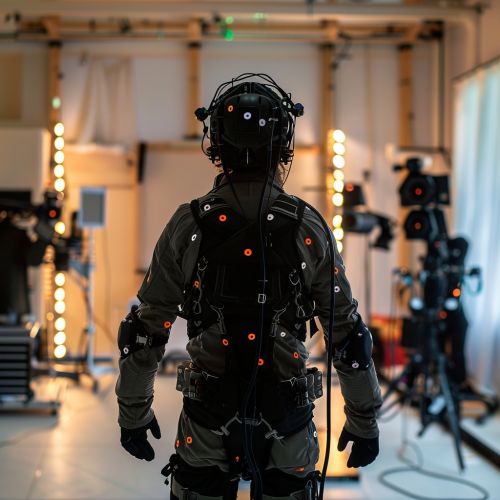Motion Tracking
Introduction
Motion tracking, also known as motion capture, is a technology that records the movement of objects or people. It is used in a variety of fields, from entertainment and sports to medicine and military applications. The process involves capturing motion data from a subject, which can then be used to animate a digital model in 2D or 3D computer animation.


History
The concept of motion tracking dates back to the early 20th century, with the invention of the rotoscope. This device, invented by Max Fleischer, was used to trace over motion picture footage frame by frame to produce realistic action. However, it was not until the late 20th century that motion tracking technology as we know it today began to take shape.
Types of Motion Tracking
There are several types of motion tracking technologies, each with its own advantages and disadvantages. These include optical, inertial, mechanical, magnetic, and acoustic tracking systems.
Optical Tracking
Optical tracking systems use cameras to track markers or features. There are two types of optical systems: passive and active. Passive systems use markers that reflect light, while active systems use markers that emit light. Optical systems are widely used in the film and video game industries due to their high accuracy and ability to track multiple subjects simultaneously.
Inertial Tracking
Inertial tracking systems use accelerometers, gyroscopes, and sometimes magnetometers to measure acceleration and angular velocity. These measurements are then integrated to compute velocity and position. Inertial systems are often used in virtual reality applications due to their low latency and high update rate.
Mechanical Tracking
Mechanical tracking systems use physical devices to measure movement. These devices, which can include exoskeletons or articulated armatures, are directly attached to the subject. Mechanical systems are often used in medical applications due to their high accuracy and reliability.
Magnetic Tracking
Magnetic tracking systems use magnetic fields to measure position and orientation. These systems consist of a transmitter that generates a magnetic field and a receiver that measures the field. Magnetic systems are often used in industrial applications due to their ability to track movement in confined spaces.
Acoustic Tracking
Acoustic tracking systems use sound waves to measure position. These systems consist of a transmitter that emits sound waves and a receiver that measures the time it takes for the waves to reach it. Acoustic systems are often used in underwater applications due to their ability to track movement in three dimensions.
Applications
Motion tracking technology has a wide range of applications, from entertainment and sports to medicine and military.
Entertainment
In the entertainment industry, motion tracking is used to create realistic animations for films, video games, and virtual reality experiences. It allows animators to capture the movements of actors and translate them into digital characters, resulting in more lifelike and believable animations.
Sports
In sports, motion tracking is used to analyze athletes' performance, improve training methods, and prevent injuries. It allows coaches and trainers to measure and analyze movements in detail, providing valuable feedback to athletes.
Medicine
In medicine, motion tracking is used in various areas, including rehabilitation, surgery, and gait analysis. It allows healthcare professionals to monitor patients' progress, perform precise surgical procedures, and analyze movement disorders.
Military
In the military, motion tracking is used for training, simulation, and unmanned vehicle control. It allows soldiers to train in realistic scenarios, simulate battlefield conditions, and control drones or other unmanned vehicles.
Future Developments
The future of motion tracking technology looks promising, with advancements in artificial intelligence, machine learning, and sensor technology expected to drive further improvements. These advancements could lead to more accurate, reliable, and affordable motion tracking systems, opening up new possibilities in various fields.
